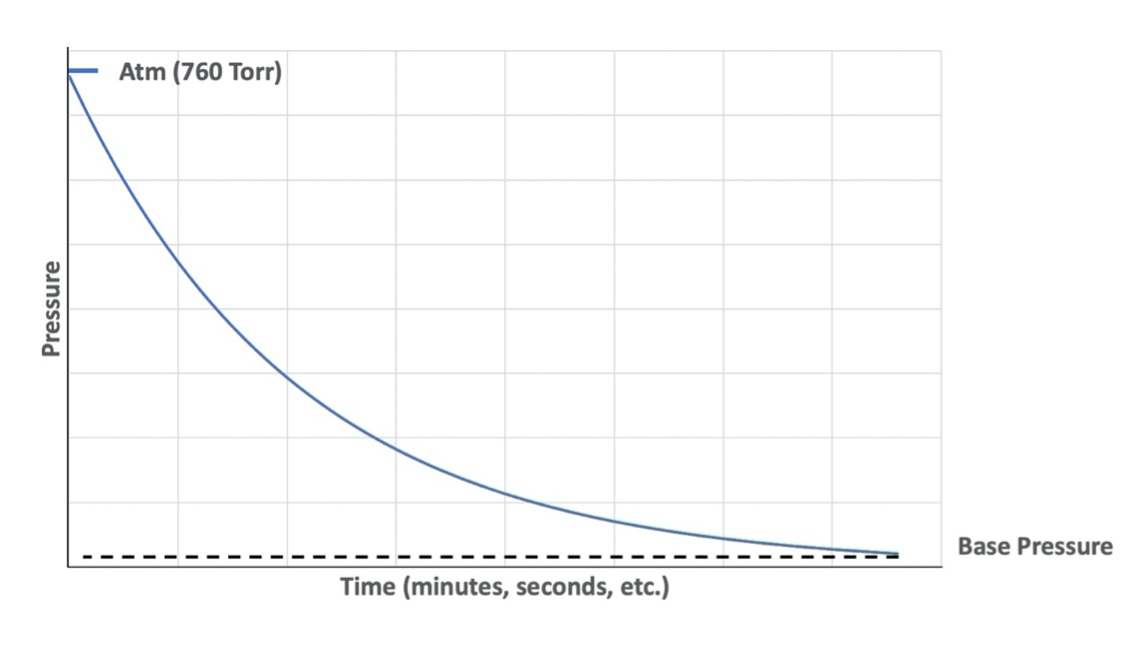Learning Activities 7.1 – 7.3: Vacuum Pump-down Curves and Vacuum Pump-down Time
Summary of Learning Activities
Learning Activity 7.1: Baseline Vacuum Pump-Down Cycle
Learning Activity 7.2: Vacuum Pump-down With Dry Source of Outgassing
Learning Activity 7.3: Vacuum Pump-down With Water Vapor as a Source of Outgassing
- Obtaining pressure vs time pump-down curves during rough vacuum system operation.
- Determining a rough vacuum system’s pump-down time from its pump-down curve.
- Obtaining pressure vs time pump-down curves during rough vacuum system operation when an outgassing source is present.
- Identifying differences in the system’s pump-down behaviors by comparing the plots of pump-down curves.
- Perform a rough vacuum system sequence of operations for pump-down and venting cycles.
- Collect pressure measurement data at prescribed time intervals over a specified period of time.
- Create pump-down curves using pressure vs time measurement data.
- Determine the vacuum system’s pump-down time from the pump-down curve.
- Identify changes in the pump-down curve due to the presence of an outgassing source.
- Identify changes in the pump-down time due to the presence of an outgassing source.
Suggested Pre-lab Assignment
- Predict the pump-down time and the shape of the pump-down curve for the system assuming no outgassing sources are present.
- Predict how the pump-down curve, envisioned in Question 1, will change with the addition of a ½” x ½” piece of dry paper towel as an added outgassing source in the chamber.
- Predict how the pumpdown curve, envisioned in Question 2, will change with a small amount of water added to the piece of paper towel in Question 2.
Theoretical Background
As a rough vacuum pump removes gas from the chamber, the chamber pressure drops non-linearly as shown in the Figure 7.1 below. According to Boyle’s law, the pressure in the chamber after each stroke/cycle of the rough vacuum pump can be calculated as:
[latex]\begin{equation} P_{after \thinspace 1 \thinspace stroke} = P_{initial} \frac {V_{initial}}{V_{after \thinspace 1 \thinspace stroke}} \end{equation}[/latex]
where
Pinitial = pressure before stroke,
Vinitial = volume of the process chamber, and
Vafter 1 stroke = volume of the process chamber + vacuum pump's expansion volume.
The volume after 1 stroke is larger than the initial volume because the gas in the process chamber expands to occupy the volume of the process chamber plus the volume of the vacuum pump’s expansion volume. As Boyle’s law suggests, the gas pressure in the process chamber and throughout the expanded space decreases. At the end of the stroke, the pump isolates the expansion volume from the process chamber volume, compresses the trapped gas and exhausts it to atmosphere. However, the pressure in the chamber volume retains its lower pressure condition. At the beginning of the next stroke the initial pressure within the chamber starts from this lower pressure condition. In this way, each iteration of the pump’s stroke cycle reduces the gas pressure within the process chamber.
Each consecutive pumping cycle achieves a smaller and smaller pressure reduction in the process chamber. After N strokes/cycles, this non-linear reduction in pressure over time can be estimated as:
[latex]\begin{equation} P_{after \thinspace N \thinspace strokes} = P_{initial} \left( \frac {V_{initial}}{V_{after \thinspace 1 \thinspace stroke}} \right)^N \end{equation}[/latex]

When sources of outgassing are present in the vacuum system, those outgassing sources add to the gas load within the system. Since the vacuum system must also remove any gas molecules present associated with outgassing sources, the presence of outgassing sources in a vacuum system will affect the pump-down time and the shape of the pump-down curve. Generally, it takes longer to pump down to a target vacuum pressure when outgassing sources are present. If the gas load from outgassing is substantial, the vacuum system may not be able to reach the target pressure. This phenomenon can be observed on the pump-down curve as a pressure plateau that corresponds to the vapor pressure of the outgassing source. If the gas load generated from the outgassing source can be reduced by the system, the vacuum system should attain its standard operating pump-down time performance with a corresponding pump-down curve showing no indications of the outgassing source.
Equipment and Materials
- Vacuum system consisting minimally of: (one each of the following components)
- Process chamber
- Absolute pressure measurement device(s)
- Vent valve
- Isolation/roughing valve
- Vacuum piping
- Rough vacuum pump
- Timer
- Barometer (not necessary if the vacuum system includes an absolute pressure measurement device with a measurement range that includes atmospheric pressure)
- Manufacturer’s specifications for the rough vacuum pump including the pump’s ultimate pressure and the pumping speed chart
- 2, ½” x ½” paper towel squares
- Beaker
- Water
Procedure
Learning Activity 7.1: Baseline Vacuum Pump-Down Cycle
- Power the absolute pressure measurement gauge(s) (Pirani gauge, convection-enhanced Pirani gauge, and/or capacitance diaphragm gauge). Allow the electronic gauge(s) to warm up.
- Identify the ultimate pressure of the rough vacuum pump from the pump manufacturer’s specifications.
- Open the vent valve and vent the process chamber to atmosphere.
- Identify and record current atmospheric pressure using a barometer or an absolute gauge on the vacuum system.
- Close the vent valve and roughing valve.
- Start the rough vacuum pump and run for few seconds.
- Open the roughing valve and start the timer at the same time.
- Record pressure measurements from the pressure measuring device every 5 to 10 seconds for 2 to 5 minutes in Table 7.1, until the pressure stops decreasing for more than 20 seconds or when pump’s ultimate pressure is approached.
- Close roughing valve.
- Turn off the rough vacuum pump.
Learning Activity 7.2: Vacuum Pump-down With Dry Source of Outgassing
- Vent the chamber. Place a ½’ x ½’ size piece of dry paper towel in a glass beaker. Place the beaker with the piece of dry paper towel in the chamber. This is a source of outgassing of air molecules that are trapped within the fabric of the paper towel.
- Repeat steps 4 – 10, recording data in Table 7.2.
Learning Activity 7.3: Vacuum Pump-down With Water Vapor as a Source of Outgassing
- Vent the chamber and remove the beaker with dry paper towel.
- Drop 2-3 drops of water on another ½’ x ½’ piece of paper towel.
- Place paper towel in the chamber.
- Repeat steps 4 – 10, recording data in Table 7.3.
Preparing vacuum system for storage
- Open the vent valve and vent the chamber.
- Remove the beaker with the piece of wet paper.
- Close the chamber, close the vent valve.
- Start the pump and run it for few seconds.
- Open the roughing valve.
- Pump the system down to the lowest pressure obtained during the nominal system pump down.
- Close the roughing valve.
- Turn off the pump and leave the system under vacuum.
- Power off the electronic vacuum gauge(s).
Data and Observations:
Table 7.1. Data for Basic Pump-down
Date data collected: _________
Atmospheric Pressure: _________
|
Time (seconds) |
Pressure from absolute pressure measurement device |
Unit of pressure |
|
Time (seconds) |
Pressure from absolute pressure measurement device |
Unit of pressure |
|---|---|---|---|---|---|---|
|
0 |
|
|
|
|
|
|
|
|
|
|
|
|
|
|
|
|
|
|
|
|
|
|
|
|
|
|
|
|
|
|
|
|
|
|
|
|
|
|
|
|
|
|
|
|
|
|
|
|
|
|
|
|
|
|
|
|
|
|
|
|
|
|
|
|
|
|
|
|
|
|
|
|
|
|
|
|
|
|
|
|
|
|
|
|
|
|
|
|
|
|
|
|
|
|
|
|
|
|
|
|
|
|
|
|
|
|
|
|
|
|
|
|
|
|
|
|
|
|
Table 7.2. Data for Pump-down with Dry Paper
Date data collected: _________
Atmospheric Pressure: _________
|
Time (seconds) |
Pressure from absolute pressure measurement device |
Unit of pressure |
|
Time (seconds) |
Pressure from absolute pressure measurement device |
Unit of pressure |
|---|---|---|---|---|---|---|
|
0 |
|
|
|
|
|
|
|
|
|
|
|
|
|
|
|
|
|
|
|
|
|
|
|
|
|
|
|
|
|
|
|
|
|
|
|
|
|
|
|
|
|
|
|
|
|
|
|
|
|
|
|
|
|
|
|
|
|
|
|
|
|
|
|
|
|
|
|
|
|
|
|
|
|
|
|
|
|
|
|
|
|
|
|
|
|
|
|
|
|
|
|
|
|
|
|
|
|
|
|
|
|
|
|
|
|
|
|
|
|
|
|
|
|
|
|
|
|
|
Observation Notes:
Describe how the pump-down process with an outgassing source compares to the baseline pump-down process.
Table 7.3. Data for Pump-down with Wet Paper
Date data collected: _________
Atmospheric Pressure: _________
|
Time (seconds) |
Pressure from absolute pressure measurement device |
Unit of pressure |
|
Time (seconds) |
Pressure from absolute pressure measurement device |
Unit of pressure |
|---|---|---|---|---|---|---|
|
0 |
|
|
|
|
|
|
|
|
|
|
|
|
|
|
|
|
|
|
|
|
|
|
|
|
|
|
|
|
|
|
|
|
|
|
|
|
|
|
|
|
|
|
|
|
|
|
|
|
|
|
|
|
|
|
|
|
|
|
|
|
|
|
|
|
|
|
|
|
|
|
|
|
|
|
|
|
|
|
|
|
|
|
|
|
|
|
|
|
|
|
|
|
|
|
|
|
|
|
|
|
|
|
|
|
|
|
|
|
|
|
|
|
|
|
|
|
|
|
Observation Notes:
Describe how the pump-down process with a source of water vapor outgassing compares to the pump-down process with dry outgassing source.
Analysis:
What is your absolute pressure measurement device (Pirani gauge, convection-enhanced Pirani, capacitance diaphragm, or other)?
What is the highest pressure measured by the absolute pressure measurement device?
Plot pressure vs time curves on the SAME linear scale graph and clearly label each curve. How do the curves differ?
Plot pressure vs time curves on the same semi-log y-axis scale graph and clearly label each curve. How do semi-log graphs differ from linear graphs? Why do we need to use semi-log graphs?
How does the semi-log graph for the baseline pump-down process differ from curves obtained when outgassing sources were present?
Compare semi-log graphs for curves with dry outgassing and wet outgassing sources.
Determine the pump-down times from atmosphere to 3 Torr from the pump-down curves.
How do the pump-down times compare?
Interpretation:
Why is the use of the semi-log y-axis scale important when plotting pressure data for the pump-down curve?

This work is supported by the National Science Foundation under grant number ATE DUE 2000454. Any opinions, findings, and conclusions or recommendations expressed in this e-book are those of the authors and do not necessarily reflect the views of the National Science Foundation.
Media Attributions
- Figure 7.1. © E. Brewer is licensed under a CC BY-NC-SA (Attribution NonCommercial ShareAlike) license

